The agricultural and food processing industries have long pioneered the automation arena as they scramble to provide sustenance to an ever-growing population. It is a sector on which almost all of us rely in order to survive and, in some cases, try to lead a healthy lifestyle. Aside from constantly evolving tools for the harvesting of raw food, mechanical sorting has been around longer than you might think, with the first food sorting machines appearing in the mid-1920s and early 1930s.
During the early days, fluorescent lamps provided powerful visible light illumination, while halogen introduced infrared wavelengths to the application. These processes gradually improved as food safety awareness increased and the arrival of a globalized market that demanded easy access to fresh produce from around the world. Fast forward just shy of 90 years and we have entered an era of 100% non-destructive, non-invasive, fully-traceable optical sorting – thanks, in no small part, to the humble LED and its good friend, the photo-detection sensor.
Ushio has developed the Epitex range of LEDs which supplies the vital illumination and sensory ingredients for many inspection-related applications. Covering a wide spectrum of ultraviolet (UV), visible, and infrared (IR) wavelengths, the Epitex opto-electronics menu caters to the needs of food industry customers from around the world. Multiple emitters of various wavelengths, from 365 nanometers (nm) – 1750 nm, can be packaged with sensors in a single tiny footprint. Accurate material analysis, nutritional information, and market valuation can be served on a plate, in the blink of an eye, thanks to Ushio’s LED technology.
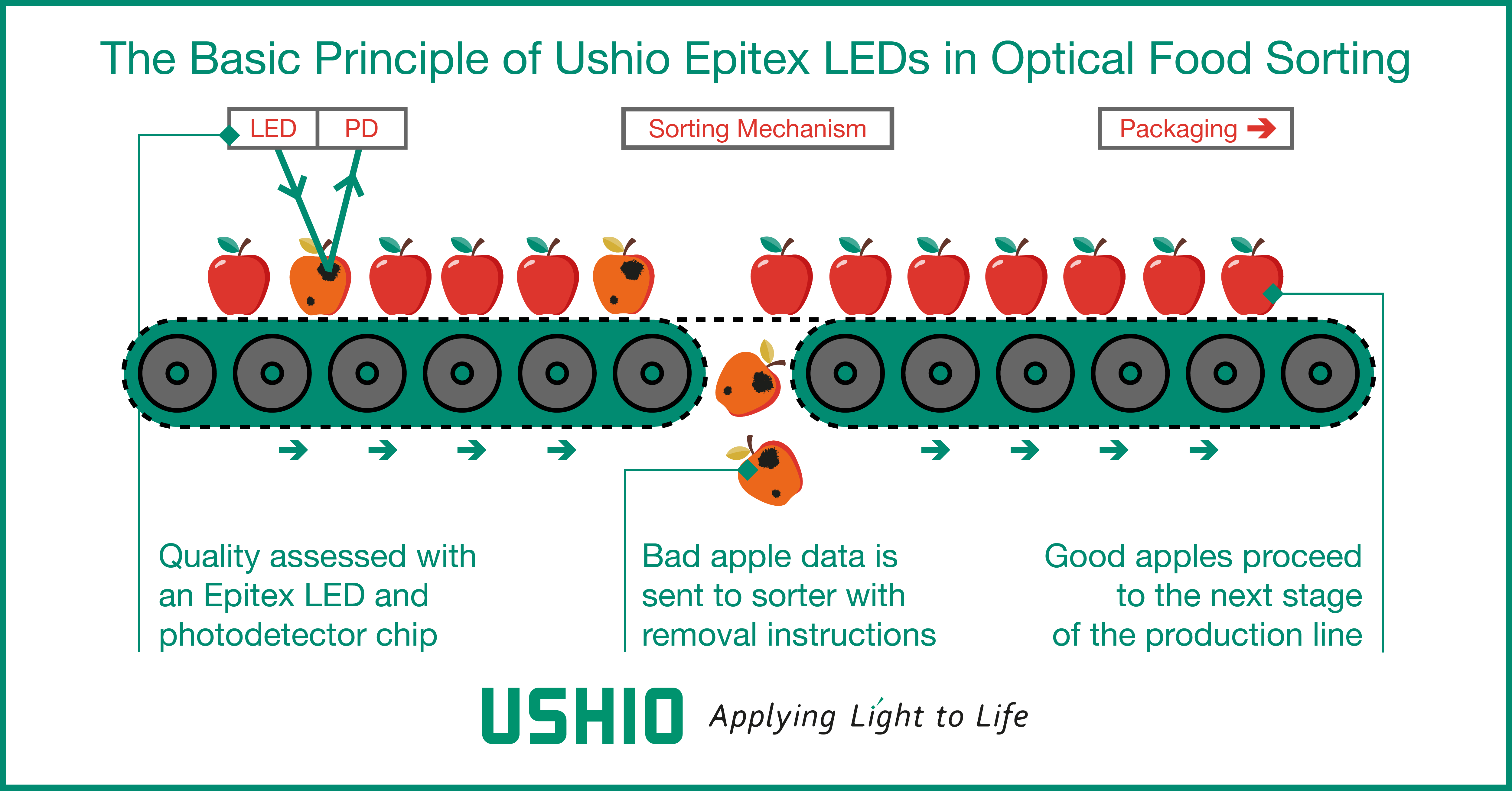
Quality assurance beyond the abilities of the naked eye
Optical inspection uses a combination of light-emitting and photo-detection chips (sensors) or cameras to obtain the color or spectral absorbency of the object. Every material, whether organic or man-made, has a different molecular composition. The structure of a given substance will reflect or absorb light rays to varying degrees and this enables us to teach machines to accurately profile items on a crowded production line.
Optical food sorting systems seek to automate all or some of the inspection, identification, and separation of materials involved in food processing. This could range from simple binary selection for foreign object removal to a more complex categorization system, such as separating fruits by shape, size, weight, ripeness, color, and the severity of any defects.
A typical agricultural application is the inspection of crops, for example, the removal of foreign objects, such as stones, that are commonly caught up in the mechanical harvesting of potatoes. Further along the food processing chain, an optical system can be deployed to monitor a batch of French fries as they are cooked. The properties of the fries are compared against data captured from a perfectly-cooked control batch, consequently the system is able to decide whether they are up to an acceptable standard or not. Overcooked fries can then be quickly discarded to maintain the consistent product standards expected by the end consumer.
Depending on the material being analyzed, a different light source will be required for the most effective results. Whether the material is grain, nuts, fruits, vegetables, or processed foods, Ushio can present wavelength recommendations from its vast collection of UV, visible, near-infrared (NIR), and short wavelength infrared (SWIR) LEDs.
The star of the show: Defining materials by infrared light absorption
Many organic materials absorb most of the rays in the range of 1000 nm – 1750 nm, which makes short wavelength infrared (SWIR) LEDs particularly popular. If more rays are absorbed, as in the case of materials with high moisture content like fruit and vegetables, SWIR imaging will produce a ‘darker’ image; by contrast, materials or substances which reflect more rays will appear ‘brighter’. This type of spectroscopy can be used to monitor the nutritional value of food, which is a critical component of agricultural and processed food production.
In particular, water, sugars, and proteins absorb the majority of the wavelengths in the SWIR band. The most common food ingredient, water, is measured for a variety of purposes, for example, ensuring the water content of baked cookies remains consistent in every batch. SWIR technology outperforms the visual capability of the human eye; this is nicely represented by bruising under the skin of an apple. The bruising can be detected by a change to the water content in the affected area, even if the apple appears to be unblemished to the naked eye. This same moisture detection ability can accurately chart the ripeness of various produce to allow them to be sent out for distribution at precisely the right time.
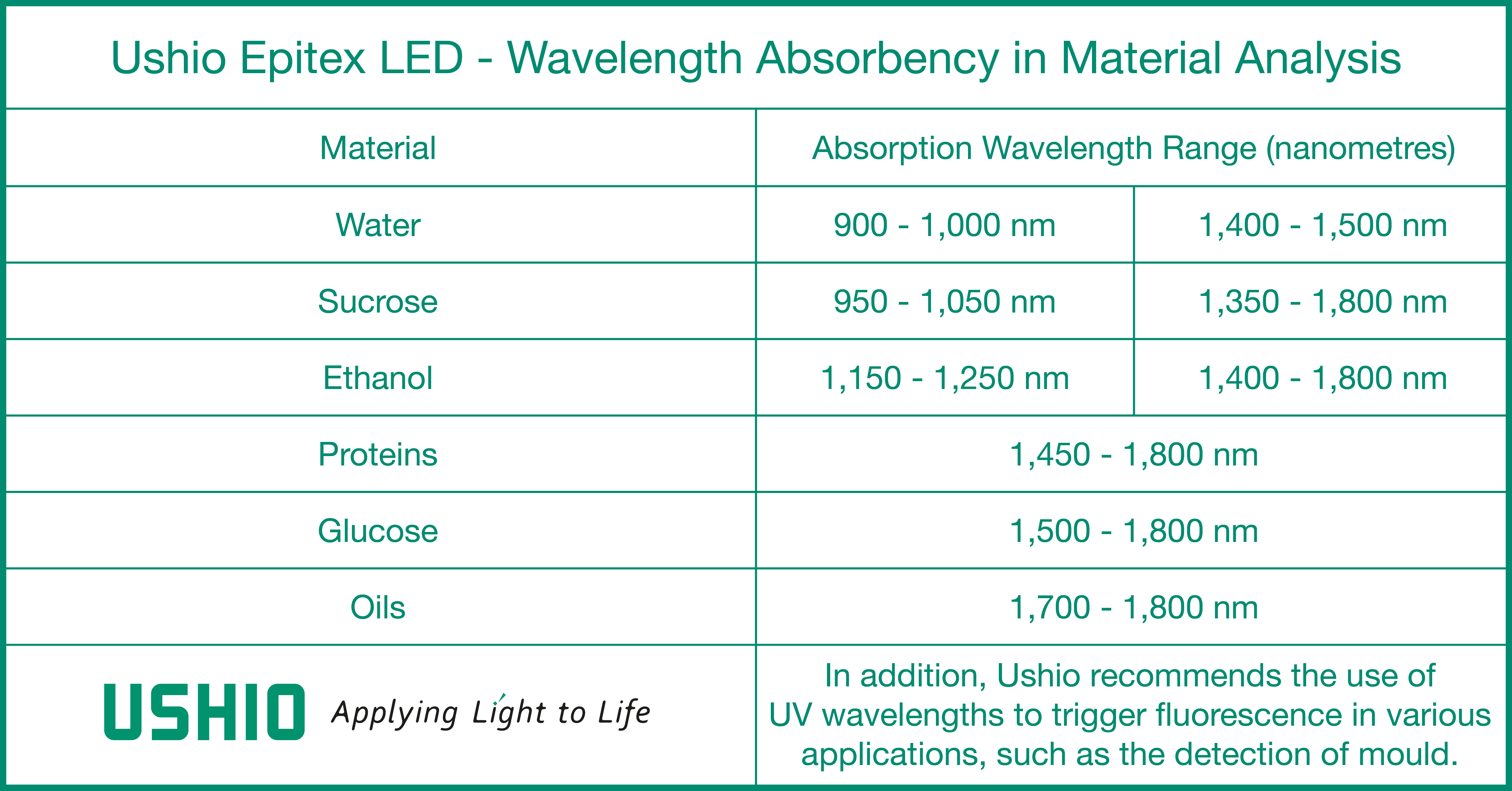
Once the light absorbency has been measured and fed into the sorting software, the system can be instructed to either accept or reject anything which passes its view with the corresponding level of light absorbency. This can also be used in product quality control to identify items which are of the correct material, but have suffered damage prior to the sorting process – much like our example of the bruised apple.
How can LED food analysis broaden your customer base?
Continuing the search for the perfect apple, sugar content not only plays a part in the taste, but also heavily influences the market value too. The SWIR sugar content analysis of an apple that possesses the perfect level of sweetness opens a variety of markets to a producer – an apple intended as a mid-morning snack may be different from the flavor desired by the brewers of a dry cider. Gaining the ability to separate these two ‘perfect’ apples into consistent batches could be the difference between having a short-term customer and one who will remain loyal for years to come.
The problem is, even if you are selling bottles of purified water, the likelihood is that your subject material contains many different molecules within its structure. Fitting all of these different wavelength emitters and sensors into a compact device sounds like a complicated, expensive headache for the electrical engineer who has to make it work.
Luckily, Ushio has mastered the art of placing up to three different chips in one package, measuring only a few square millimeters. The chips can be an assortment of LEDs and sensors, so each package effectively reduces its occupied space on a circuit board by two-thirds. It is even possible to analyze various material components in great detail by cycling through different illumination wavelengths. By independently pulsing light-emitting chips, in conjunction with a high-speed camera, it is possible to obtain spectroscopic images that tell the whole story. Ushio is currently developing an LED package that that could simultaneously emit up to eight wavelengths, or alternate between them at the will of the operator.
Configuration options for production line illumination and detection systems
The figures below offer two examples of how Ushio’s LEDs can be integrated into the sorting section of a production line:
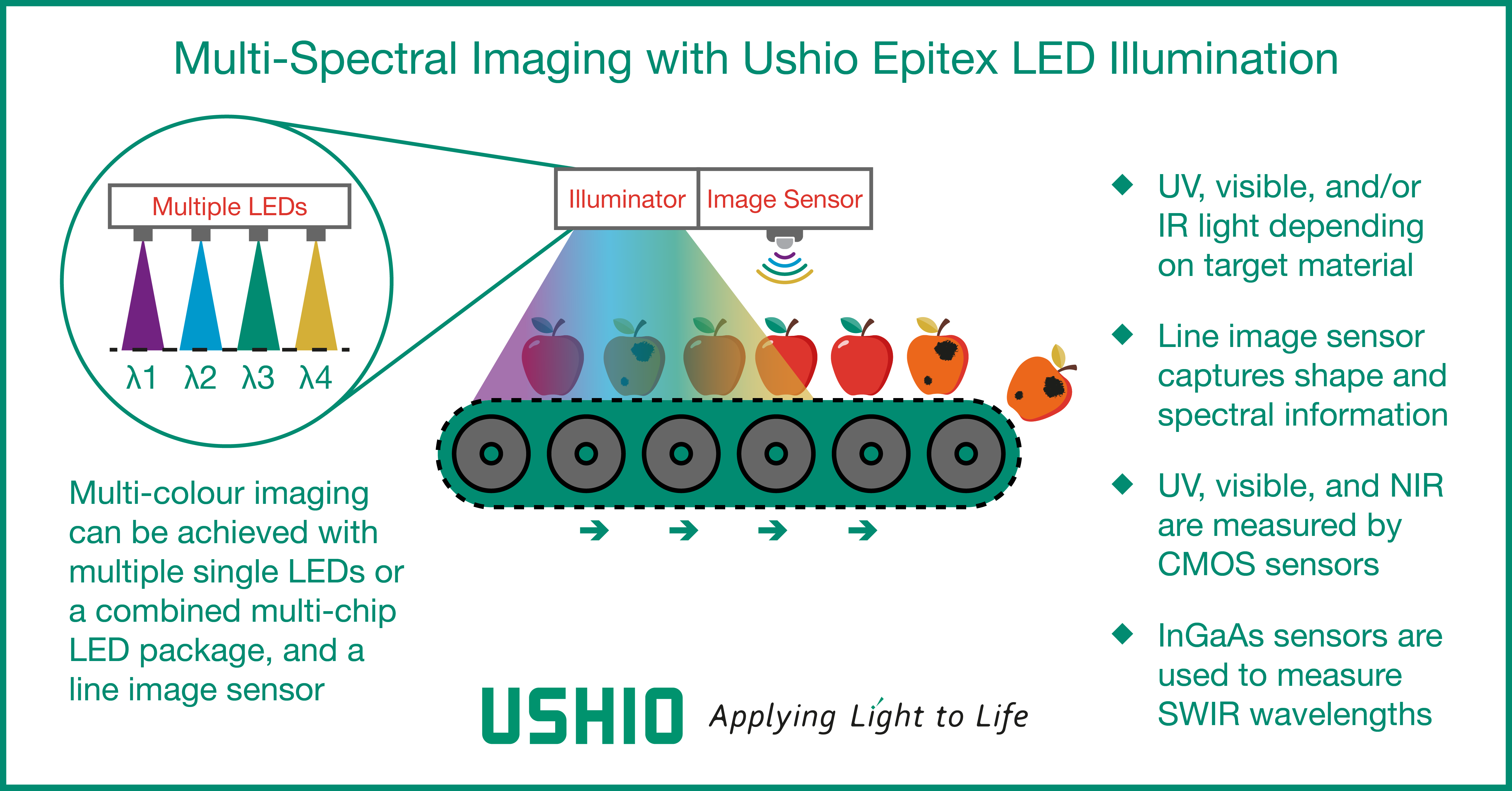
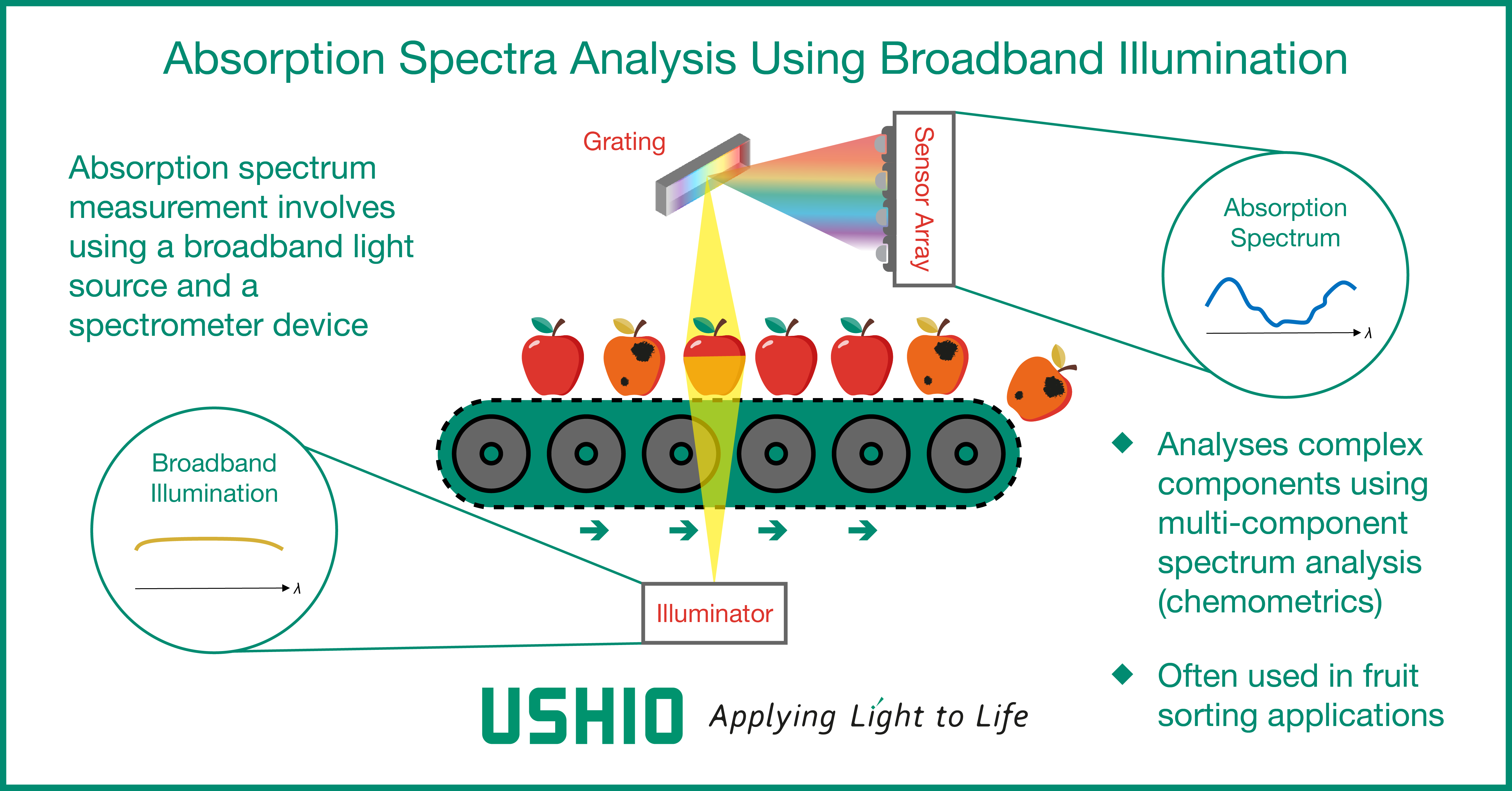
Which Epitex LED is right for your food sorting application?
The SMBB family is the most versatile set of LEDs on the market. With a copper heatsink-equipped 5 mm2 package, these record-breaking LEDs are available in single or multi-chip form. This means sorters can have a single 1 mm2 high-power chip at their disposal; or if your sorting device requires even more power, the multi-chip SMBB package can be mounted with up to three chips for triple the output.
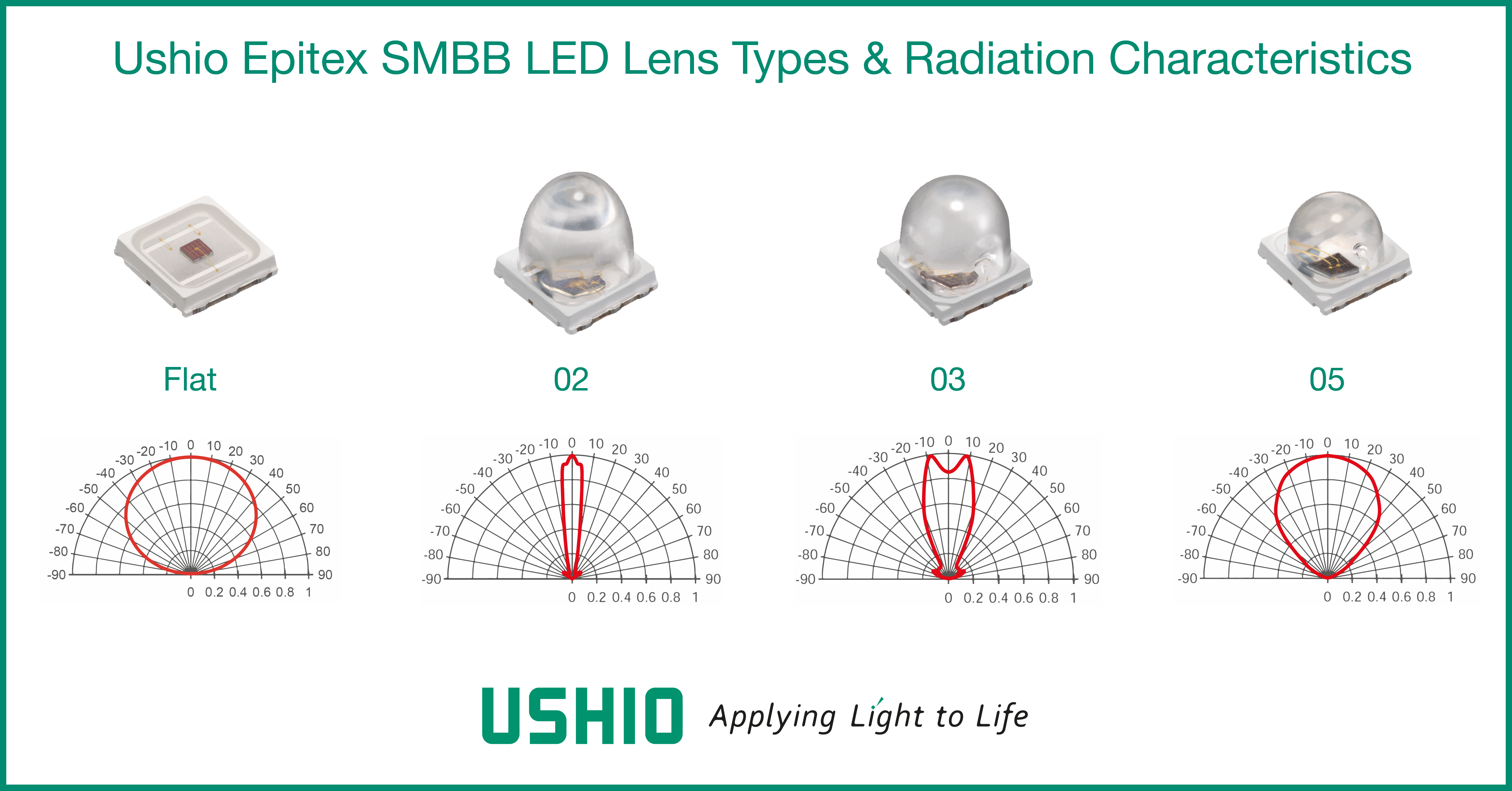
While the SMBB family remains popular, sometimes Ushio’s clients are looking for a single-chip package with a smaller footprint. Of course, Ushio would not want to compromise the high-power offerings from the SMBB class, so the EDC family was developed. Offering the same wavelength range as the SMBB packages, EDC LEDs bring the true benefits of miniaturization by taking up a space of just 3.5 mm2.
An EDC package features a ceramic base, which serves as an ideal heatsink, and provides excellent isolation from the circuit. The EDC family is mounted with a single 1 mm2 chip to remain capable within the same applications as single-chip SMBBs. The key difference, however, comes in the form of the smaller footprint, which allows extra room for more LED packages or the addition of other components in need of more space.
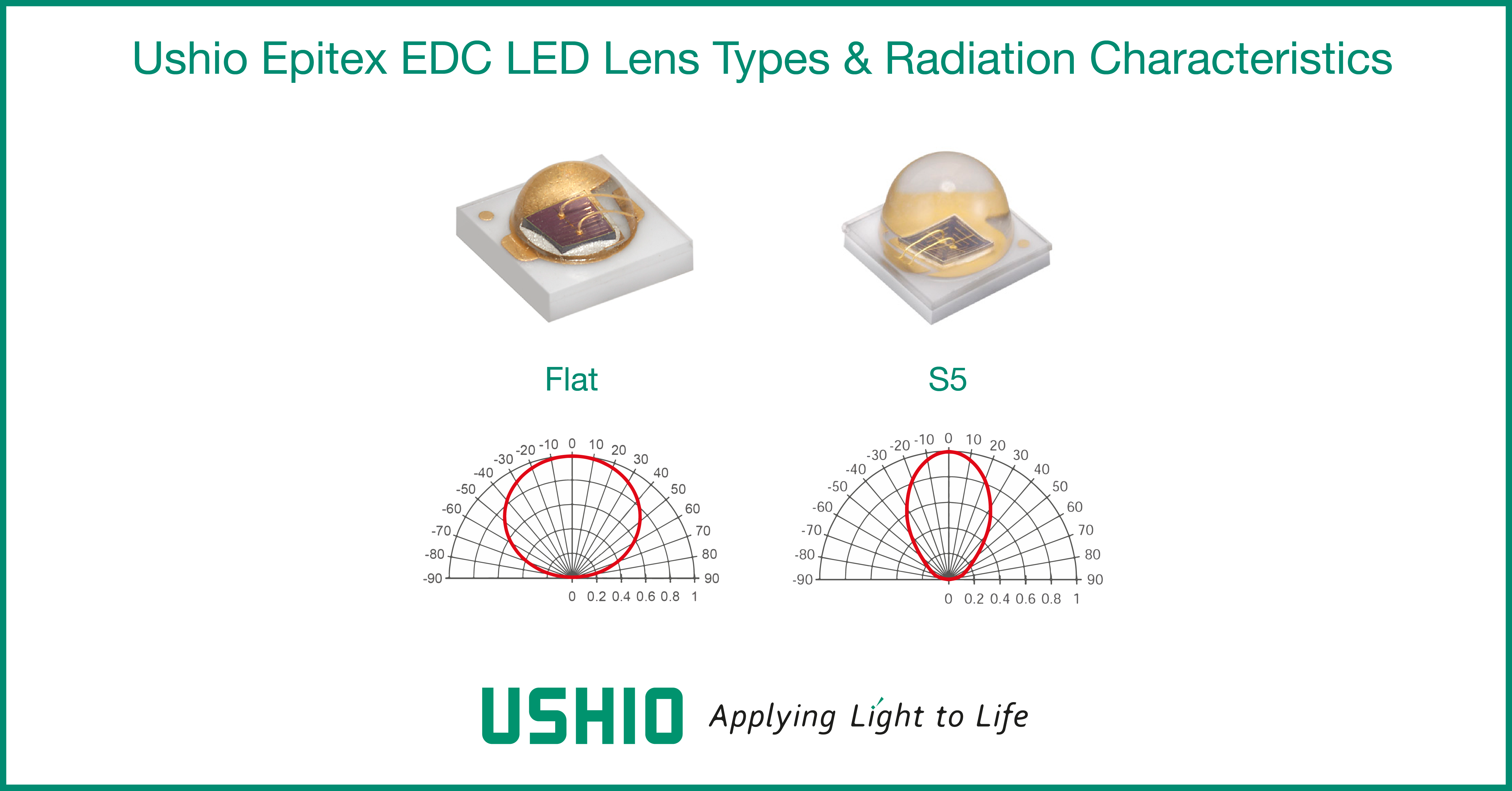
While Ushio offers various different LED package types, they are all compatible with the 365 nm – 1750 nm spectrum in increments of 20 nm (below 1000 nm) and every 100 nm (over 1000 nm). By sharing detailed material information and device specifications with Ushio’s experts, every client receives an informed recommendation that is unique to their particular food sorting project. Within Ushio’s huge LED collection, however, there are two stand-out recommendations for food sorting applications:
Epitex D Series: Ushio’s top recommendation for SWIR food sorting
Ushio’s flagship high-power SWIR LED collection is the Epitex D Series. Following the prior success of the S Series, the introduction of the Epitex D Series achieved the world’s highest output power and efficacy. While these LEDs are suited to many machine vision applications, such as automatic number plate recognition (ANPR), they also play a vital role in food sorting. In particular, the SMBB1050GD LED is frequently combined with an SWIR camera or sensor to bring high-speed, high-power material analysis to the food sorting application.
In the case of a low-power LED preference, D Series chips can be mounted in SMT or molded LED packaging; while the 1 mm2 high-powered chips are mounted in EDC, SMBB, and TO-66 packages. For the majority of wavelengths, a two-fold improvement of output and efficiency is attained compared to the S Series; however, the high-power versions have ramped up their forward current to 1 Ampere (A) and gain an output power boost of up to four times that of the S Series. The resulting efficiency improvement gives operators the opportunity to enjoy cheaper power output, thereby reducing the overall cost per Watt (W).
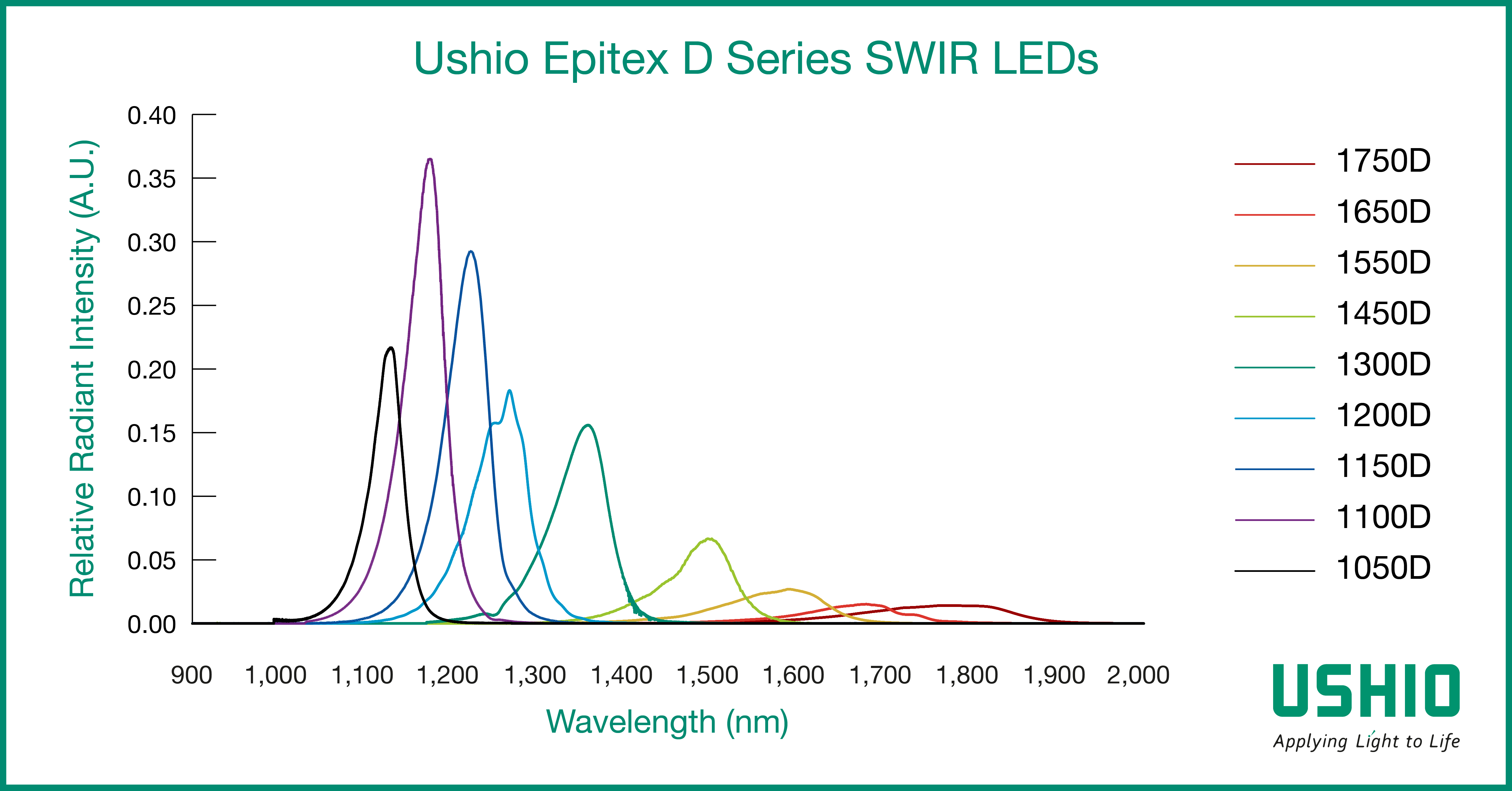
Epitex D Series benefits
-
World’s highest output power and efficiency ever achieved by an SWIR LED, with a two to four-fold improvement over the conventional Epitex S Series
-
Wide range of wavelengths can be chosen across the SWIR sector, between 1000 nm and 1750 nm
-
Excellent customization options – work alongside Ushio to design the perfect solution to your food sorting needs with variations on wavelength, chip size, number of chips, lens type, photodetectors and more
Epitex DS Series: Ushio’s top recommendation for NIR food sorting
The NIR portion of the electromagnetic spectrum includes wavelengths of 700 – 1000 nm, and is an excellent tool for detecting organic materials. NIR is the closest region of infrared radiation to visible light, beginning just beyond the limit of detection by the human eye. Ushio’s NIR LEDs are used to briefly illuminate the subject for a high-definition infrared camera, much in the same way the ‘flash’ works in a conventional camera.
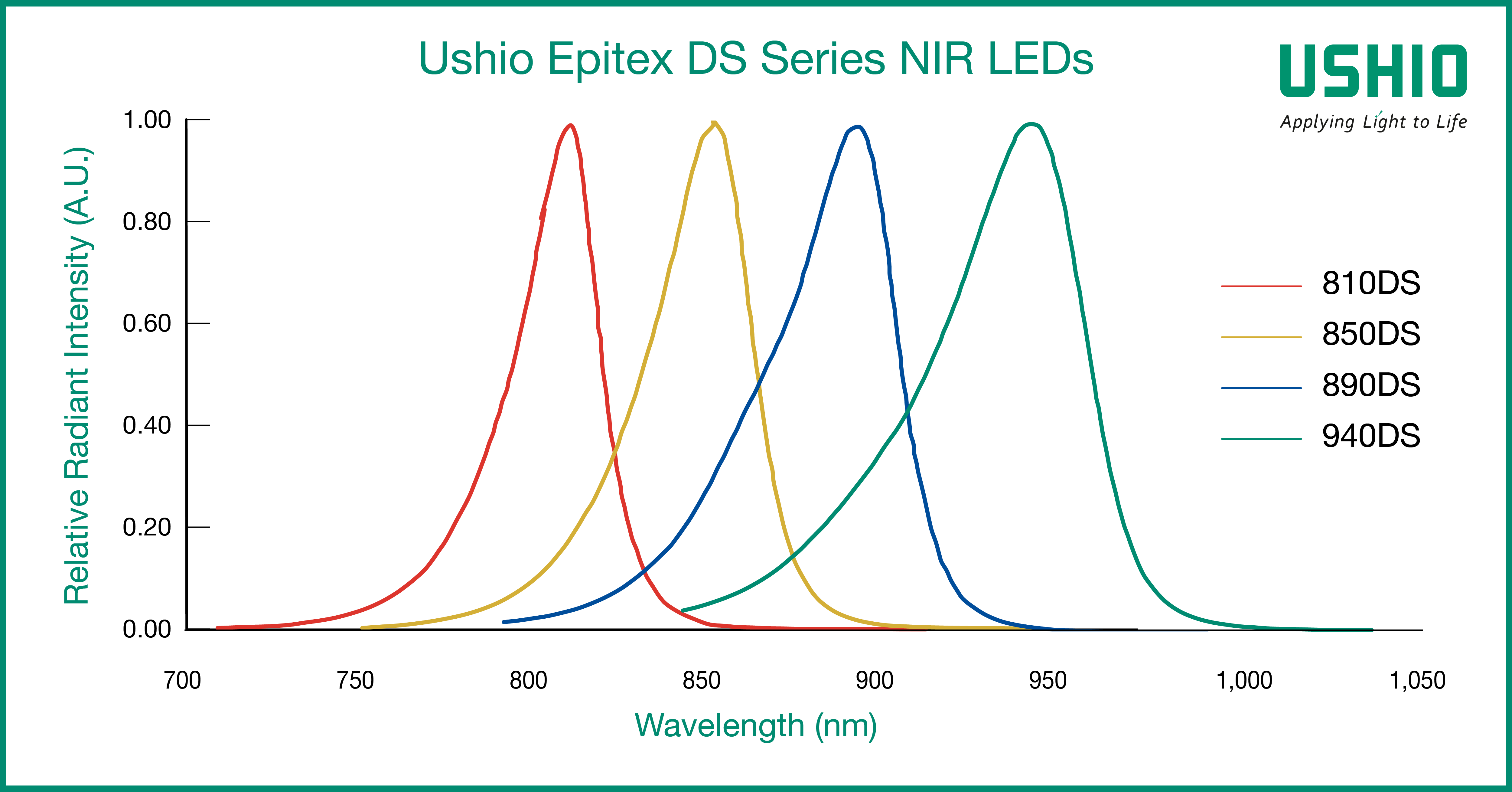
Available in both low and high-power varieties, lower power NIR emitters, such as mold type LEDs, are generally considered ideal for smaller devices; however, the general rule of infrared imaging is that higher power achieves a clearer image from greater distances, so Ushio recommends the DS Series LEDs for that reason. The clarity of the image is also affected by the optical lens chosen to accompany the chip. Depending on how the light is focused by the lens, you can achieve a more intense image or choose to illuminate a wider area.
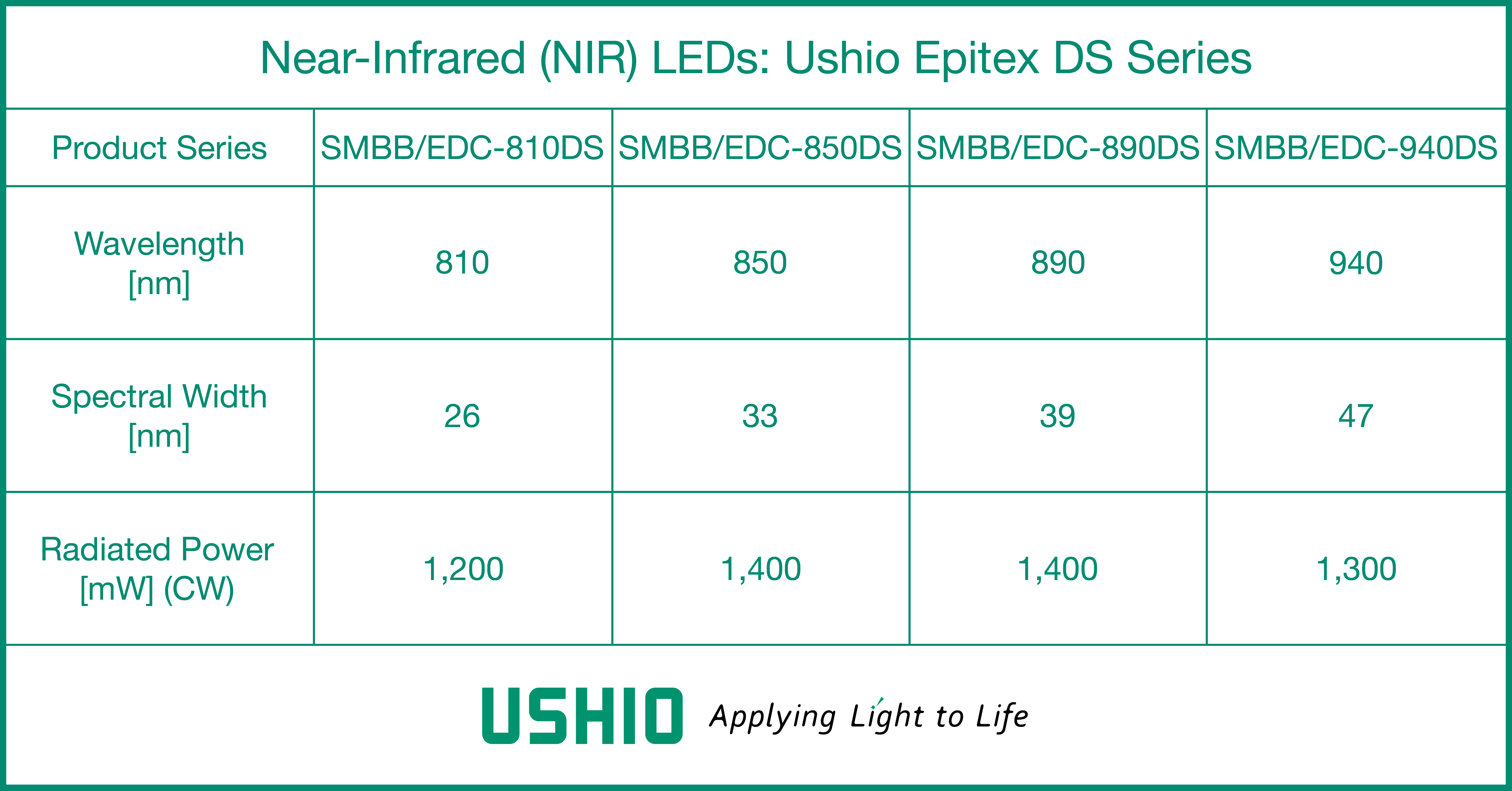
The DS Series chips offer the highest power of their class, and remain Ushio’s top recommendation for NIR sorting applications that require the pinnacle of high-speed accuracy.
Contact Ushio for advice on all solid state lighting applications
If you would like to make an enquiry about Epitex LED, Ushio’s regional SSL teams can be contacted via the following links:
United States: https://www.ushio.com/contact-us/
Europe: https://www.ushio.eu/contact/
Asia: https://member.ushio.co.jp/en/members/contact/product-led
2021 Infrared Sensing Market Trend- 3D Sensing, LiDAR, SWIR LED
Release: 01 January 2021
Format: PDF
Language: Traditional Chinese / English
Page: 175
|
For further information about the report, please contact:
|
|
|
|
|
Global Contact: |
ShenZhen: |
Grace Li
Tel : +886-2-8978-6488 ext 916
E-mail :Graceli@trendforce.com |
Perry Wang
Tel : +86-755-82838931 ext.6800
E-mail : Perrywang@trendforce.cn |











